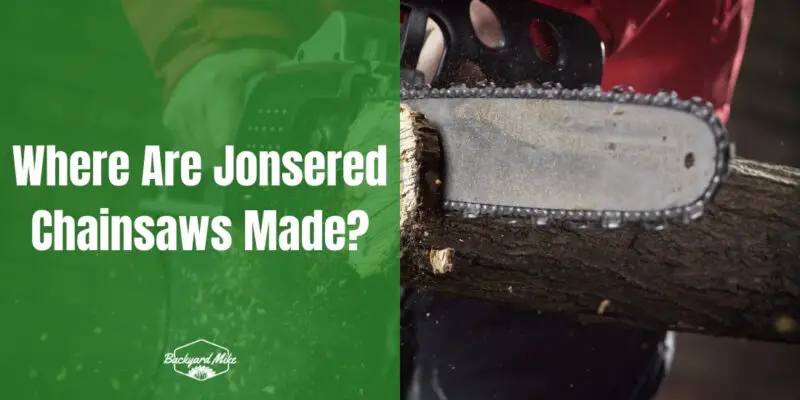Jonsered chainsaws are crafted by Husqvarna Group, a leader in outdoor power products, with production in various global facilities, including a significant site in Nashville, Arkansas. This facility spans 874,000 square feet and even utilizes solar energy, reflecting modern manufacturing practices. Regardless of where they're made, Jonsered chainsaws maintain a reputation for quality and innovation. If you wish to discover more intricate details, consider exploring further into the brand's rich heritage.
Key Takeaways
- Jonsered chainsaws are manufactured at Husqvarna facilities globally.
- Production moved from Sweden to Husqvarna's global locations after 1984.
- A major production site is in Nashville, Arkansas.
- The Nashville facility uses solar energy and covers 874,000 square feet.
- Chainsaw production is integrated within Husqvarna's operations for efficiency.
Historical Roots and Brand Evolution
Founded in 1832 in Jonsered, Sweden, Jonsered started as a textile firm, producing essential items like canvas for sailboats and fire hoses.
Over time, the brand evolved considerably. In the 1950s, Jonsered's manufacturing timeline shifted as they ventured into the chainsaw industry, introducing semi-diesel models like the "Rocket." Although they initially focused on different products, Jonsered became known for lightweight, one-man chainsaws since 1954, solidifying their reputation in the industry.
In the 1950s, Jonsered transitioned into chainsaws, launching innovative semi-diesel models like the "Rocket".
By fully converting to gas-powered chainsaws, they revolutionized forest work. In 1954, Jonsered's innovative spirit led to the creation of the first lightweight one-man chainsaw.
This milestone marked a turning point in their brand history, establishing them as a leader in forestry tools.
Understanding Jonsered's journey from textiles to chainsaws provides insight into their enduring impact and evolution within the industry, fostering a sense of belonging among users.
Global Manufacturing Presence
To understand Jonsered's global manufacturing presence, it's crucial to recognize its integration within Husqvarna AB, the world's largest producer of outdoor power products.
You're part of a community that appreciates quality and heritage, and Jonsered, now under Husqvarna's umbrella, has always delivered on these fronts.
With products once exported worldwide, global collaborations were key to Jonsered's market strategies. Their chainsaws, lawnmowers, and more reached diverse markets, with North America as a major hub. Jonsered began producing the chain saw model Raket in the 1950s, which achieved major success and began global exports.
Shared manufacturing lines with other brands allowed for efficient production. Husqvarna's emphasis on supply chain excellence guaranteed smooth operations and reliability across its brands.
Even as Jonsered products were discontinued in 2022, Husqvarna continues to support existing users, maintaining that sense of belonging.
Key Production Facilities and Locations
Although Jonsered chainsaws are no longer produced in their original location, understanding their key production facilities and locations is important for grasping the brand's evolution.
Jonsered began in the 1950s in Jonsered, Sweden, under Jonsereds Fabrikers AB. Initially, it was a textile mill founded by William Gibson in 1832. Over time, it shifted from textiles to woodworking, ultimately focusing on chainsaws.
As the brand's production history evolved, it saw facility changes due to ownership changes. Electrolux acquired Jonsereds in 1979, closing the Jonsered factory in 1984 and moving production to Husqvarna facilities. Today, Husqvarna owns Jonsered, with various manufacturing sites globally, including Sweden and the USA, ensuring a broad production reach. Husqvarna's Nashville, Arkansas facility, which covers 874,000 square feet, is a significant part of their operations, utilizing solar energy to power production.
Engineering and Research Development
When it comes to engineering and research development in chainsaws, staying ahead involves embracing innovation and technological advancements. You're likely to notice key innovation trends that focus on adopting new materials like aluminum, which make chainsaws lighter and more efficient. Design engineering plays an essential role, especially in ergonomic enhancements with vibration dampening systems and user-friendly handles. Cutting-edge chain technology also contributes to improved efficiency and reduced wear. Safety remains a top priority, with features like inertia-activated chain brakes. Regarding performance, optimizing power-to-weight ratios guarantees chainsaws deliver better results. Battery-operated chainsaws using Lithium-Ion batteries have become increasingly relevant due to their portability and quiet operation. Additionally, energy efficiency is a focal point, with ongoing efforts to reduce fuel consumption and emissions. Advanced materials and computer-assisted design are paving the way for durable, eco-friendly chainsaws. Amidst these advancements, high mobility continues to drive demand in the construction and forestry industries, highlighting the importance of versatile and powerful chainsaw designs.
Supply Chain and Component Sourcing
Understanding the supply chain and component sourcing for Jonsered chainsaws is vital to grasp how these tools are brought to life from concept to market.
You'll find that sourcing strategies focus on securing high-quality materials to guarantee durability and performance. The supply chain is a complex network, integrating diverse suppliers to meet the demands of production efficiently. Jonsered saws are manufactured in multiple countries, showcasing a global approach to production and sourcing.
Here are key elements involved:
- Metals like steel and aluminum are important for frames and engine parts.
- Plastics are sourced for casings and handles.
- Electronic components provide reliable ignition and controls.
- Chains and bars come from reputable suppliers, emphasizing material quality.
- Rubber materials enhance grips and vibration damping.
These components are vital, forming the backbone of Jonsered chainsaws' production process.
Frequently Asked Questions
Is Jonsered Still an Active Brand in the Market?
Jonsered's not an active brand in the market anymore, but you can still feel its legacy. Brand evolution led to a reduced market presence, yet you're part of a community cherishing its innovations and history.
Who Currently Owns the Jonsered Brand?
You're curious about the current ownership of Jonsered, a brand with rich history. Husqvarna Group owns it now, carrying forward its legacy. Even though it's discontinued, you can still enjoy support and feel part of its community.
Are Jonsered Chainsaws Environmentally Friendly?
Actions speak louder than words. You'll find that Jonsered chainsaws, now under Husqvarna, incorporate sustainability practices and eco-friendly features. They focus on efficiency and waste reduction, helping you feel part of a greener community.
What Are the Main Competitors of Jonsered Chainsaws?
You'll find Jonsered chainsaws facing tough competition from Husqvarna, with similar features and performance. Stihl offers strong alternatives, known for reliability. Echo and DeWalt also compete, providing options that balance power, budget, and durability for users like you.
How Does Jonsered Ensure the Quality of Its Chainsaws?
You'll appreciate that 100% of Jonsered chainsaws undergo rigorous quality control, ensuring reliability. The manufacturing process blends global components with strict testing. Trust that owning a Jonsered means you're part of a tradition of excellence and innovation.
Conclusion
To understand where Jonsered chainsaws are made, explore their historical roots and brand evolution. Consider their global manufacturing presence, focusing on key production facilities and locations. Investigate their engineering and research development to grasp innovation's role. Examine the supply chain and component sourcing for a complete picture. By doing this, you'll appreciate the precision and dedication behind each chainsaw, ensuring you make informed decisions when selecting a tool that embodies both tradition and modern engineering.


